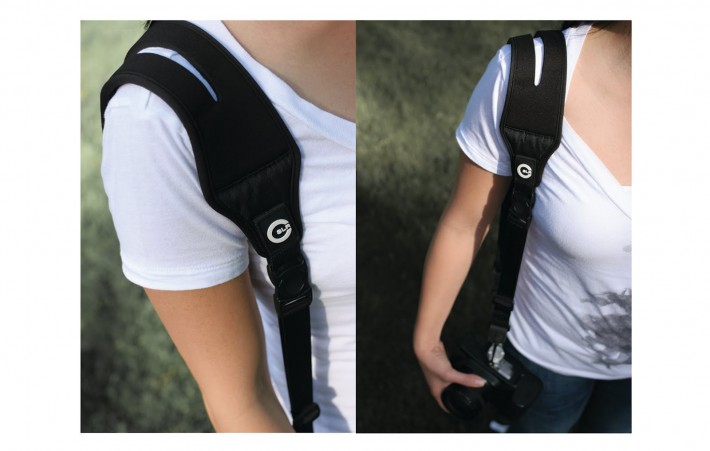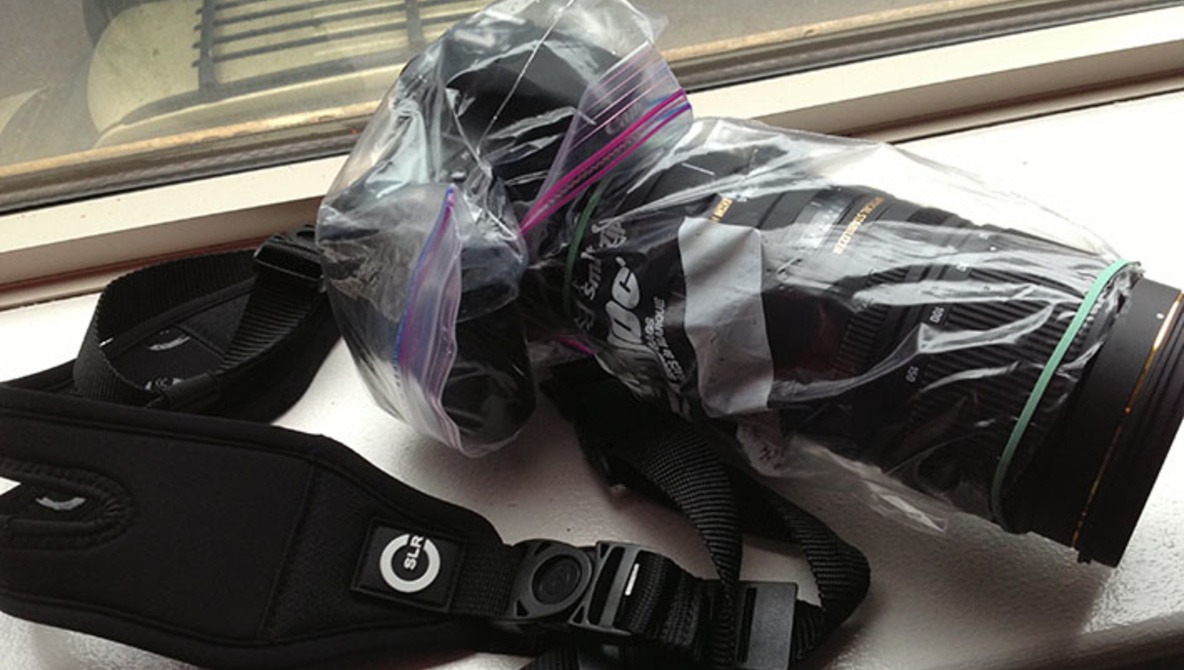When I test products, I like to have a plan. I put together what I think the product should handle and then carefully execute and document the situation. It's the easiest and best way for me to give a fair assessment of the gear. A relatively straightforward and planned review was on my schedule for the C-Loop and Glide Strap but instead, I found myself in the midst of a natural disaster and the desire to capture the moment as best I could. This required the cooperation of this camera strap, and inadvertantly, resulted in this review.
To be completely honest, straps aren't really something I had put a lot of emphasis on. They hold the camera. As a studio photographer primarily, the first thing I tend to do with a camera right out of the box is remove the strap. It just gets in the way and prevents me the freedom and range of motion I require while in the studio. However, when I was caught in Hurricane Sandy last week, I wanted to go out into it and document the situation to the best of my ability. To do this, I for the first time in years required a strap. I happened to bring along the new Customer SLR strap that the team based out of San Jose sent me a couple weeks before PhotoPlus. I happened to pack it along with my Canon 60D, a Sigma 50-150mm f/2.8 in my Lowepro Fastpack 350 bag. Everything in that bag happened to be exactly what I needed to shoot the situation when the storm hit. Let me explain.
When I left for New York, there was no talk of any hurricane. I did not come prepared for the situation, and I certainly didn't have the materials on hand that I would normally require to document it. When the storm hit, I had to make use of what I had.
The apartment where I was staying had only a few things, including one candle, two rubber bands, and a box of Ziplock sandwich bags. Now obviously I made use of the candle since the power was out in lower Manhattan for more than five days. But the rubber bands and Ziplock bags would prove to be my way to safeguard my camera when I ventured out into the storm-soaked streets. Here is why I was glad I had my 60D: the sandwich bags weren't big. My 60D just barely fit, which means if I had opted to bring the heavier and larger 5D Mark III, I would not have been able to storm protect the camera. I took two Ziplock bags, cut them in the proper places, and zipped/rubber banded them together. The result was a relatively weather proof setup of a 60D and a 50-150mm f/2.8 lens.



The last step was securing the camera to my person, which is where the Custom SLR C-Loop and strap came in. The C-Loop attaches to the bottom of the camera in the tripod screw hole, an approach that is becoming more common on after-market camera straps. From the C-Loop attaches the strap, which secures to the C-Loop with two large plastic clips and woven cords. Those cords then attach to the nylon and neoprene body strap. It's a secure package, and one that I would find to be extremely comfortable.
If you haven't handled the 50-150mm Sigma lens, it's not light. In fact, it was one of the only complaints I had against the lens when I reviewed it. I knew this lens and body combination would be heavy, but I didn't want to miss the opportunity for a shot just because I was too far away. With the Custom SLR strap, I actually didn't have to make the tough decision of whether or not to remove the large glass. The strap moves and stretches with you as you walk, which means that the bulk of the weight feels less heavy. I walked miles up and down Manhattan for several days, each time with this lens across my body. I can honestly say, I hardly noticed it. The several pound combination of gear slung over my shoulder meant nothing, and I was free of the weight distraction and able to focus on getting the shots I wanted. If I had worn the strap Canon included with the camera, this would not have been a pleasant experience.

Custom SLR also made their strap able to move when you want to bring the camera to your eye. Instead of being fixed attached to the body strap, the connection point between the body strap and the C-Loop is mobile, moving up and down the nylon portion of the strap. This means picking up the camera with your right hand and pulling it up to your eye is a smooth, seamless and comfortable affair. To be clear, I do not wear this around my neck of just off one shoulder. When I wear this strap, it comes across by body, with the neoprene strap over my right shoulder and camera slung down by my left hip. I find this setup to be the most comfortable for me, and keeps the weight evenly distributed.
The only thing that would have made this strap perfect would be a way to hide or roll-up the nylon straps. Being a small guy, the straps were tightened quite a bit, which means a lot of excess nylon dangling around my body.

The C-Loop is a little pricey at $40, so if you already use a bottom-mounting camera bracket for your SLR, then you're good. It's a solid piece of equipment, but you don't need to run out and get one right away if you already have something that you like. However, I can't recommend this strap enough. For less than the C-Loop at $36, it's a heck of a deal. It's extremely comfortable, and I have one on both my camera and my laptop bag. The original had some fraying issues on the edges of the neoprene, but this new version has some upgraded stitching that looks to have resolved that issue. You should pick one of these up if you are in the market for a strap, but keep in mind you will need the C-Loop or something like it in order to use it.

I never intended to write a review of the Custom SLR strap and C-Loop in this manner; it just happened. I think the impromptu nature of the situation, coupled with the fact that I was able to shoot New York with little to no distraction, serves to prove that this strap just works. I walked for five to six hours a day with this camera support device slung across my body, and it barely felt any different than walking around without it. I can't recommend this strap enough for those of you on long editorial photo expeditions who just want to forget about the camera you are carrying once in a while and just focus on what's happening and getting your shot. This strap allows you to do that, and in my book that's a great success.







Lets spend all our money on a camera strap and not rain gear....
Jaron, would you know if this is better than the Rapid strap, or you don't have any experience with the Rapid?
I actually haven't used the Rapid straps. I've seen them on people, and they are made of Nylon mostly right? The benefit of this is that it moves with you and makes the weight seem less heavy. I think Rapid proportionally moves the weight around your body to try and achieve the same result.
Ive been using a rapid strap for about 2 years now, I won mine, having never considered using aftermarket straps. I love that thing now and don't shoot weddings without it.
Now a the beginning of this year i was given a Custom SLR strap and cant say i like it as much. might be slightly more comfortable. but i found it getting twisted up all the time and all the plastic fittings kinda scared me. sorry for rambling but i would chose the rapid over the c-slr.
Thanks. That's actually very helpful. I've been wondering how the Rapid stacks up against the C. I guess I'll stay with my Rapid.
I have both, the CSLR is much more comfortable and provides a very cool tripod mounting plate built in. It also hangs less. It is more bulky though which could become an issue but it also offsets the camera from your body which makes it more comfortable when it wraps around your hips.
Thanks for sharing. Awesome tips. And love how one can shoot in the rain in a pinch with zero excuses. Very helpful!
Rapids are great (I own one)- however, you *cannot* mount your camera onto a tripod with the strap attached unless you have a specific Manfrotto RC-2 tripod mount- which nobody i knows even uses. The only viable solution that i've seen (ironically) is to use one of Custom's tripod mount plates which moves the screw hole for the ring out in front under the lens barrel so that you can screw your tripod mount plate on that and then be able to attach it to your tripod.
It's surprising how much r&d BlackRapid probably put into the design of their gear, yet how little they put in to think in terms of how a photographer would use it. Aside from that a very well made piece of gear.
Just attach the Rapid to the orignal attach point or the camera... ;)
I actually have my Manfrotto 200PL-14 RC2 attached to my camera at all time. In fact, I threw away the mount that came with the Rapid the minute I bought it.
I'd be interested to see a review on the new Joby strap.
I've always wondered how these types of straps would work when tied to a battery grip especially a cheaper 3rd party grip. I have fears of snapping followed by crashing
I have a Rapid R on an EOS 1n w/ the 8AA cell battery grip (OEM) and a 70-200 2.8 and it's just fine from a snapping point of view. Now if you try running, sitting down too rapidly, or leaning over oddly - that's a lot of weight swinging around!
"too rapidly" - I see what you did there :D :D
I hate mine. Attaching the C-loop to the tripod mount makes the whole camera hang weird and upside-down, and the lens ends up bumping against my hands as I walk. If you use it enough, the C-loop eventually becomes loose, and your camera falls right off.
I've tried it with different lenses, and attaching to the lens tripod mount, still sucked. At least it was expensive.
Try a lighter carbon fiber tripod.
The Spyder holster is by far much better than my black rapids
http://www.spiderholster.com/
Nice review. I
have enjoyed all their products including the M-Plate since they
launched on Kickstarter. Good to see stuff still made in the USA.